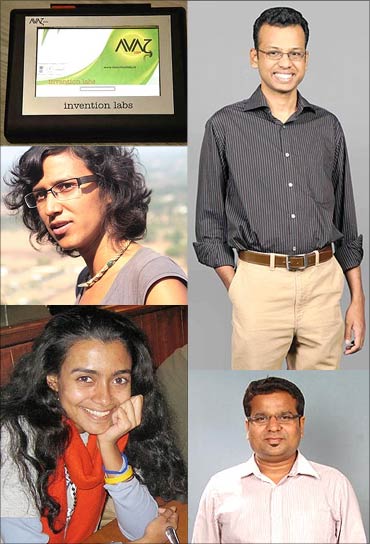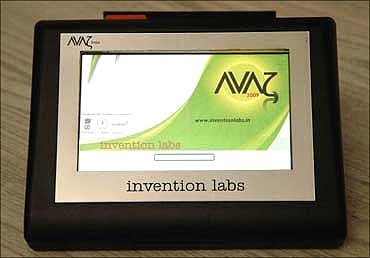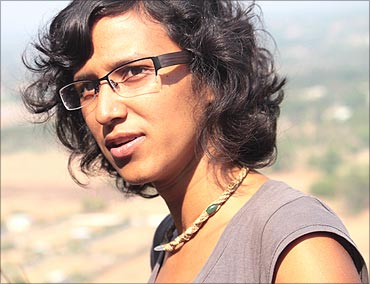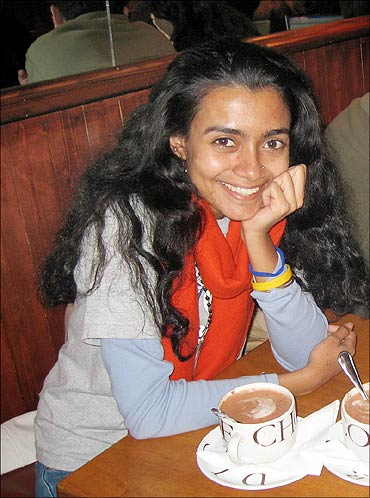A communication system for people with speech disabilities, using a digital camera to scan vision-threatening symptoms, and a system that sends a mobile alert to users on a gas leakage are some technology innovations that the Massachusetts Institute of Technology has shortlisted from India.
MIT's Technology Review India has selected 18 innovations from a nominee list of 200.
Chennai's Ajit Narayanan was awarded as the 'Innovator of the Year' for his project, 'Avaz', on empowering those with speech disabilities.
Alefia Merchant, 32, pursuing medical studies in Canada, was awarded as 'Humanitarian of the Year' for her effort to come up with an easy method to spot eye disorders in young children.
Orissa's Gautam Kumar's simple gas detection system, Suraksha, using a sensor and communication module to issue a warning to the user's registered mobile phone, won him the 'Social Innovator of the Year' award.
Click NEXT to read about some of these innovations. . .
How they adapted technology for human need
Image: Avaz.Avaz: Ajit Narayanan
Innovation Labs, started by Narayanan, has been incubating at the Indian Institute of Technology, Madras, since 2007, with the sole purpose of using technology that benefits users in India.
Avaz is a communication device for people with speech disorders.
The technology works by converting limited muscle movements, such as head or finger movements, into speech.
Avaz works on the principle of scanning.
It shows options on a screen and presents a highlight that moves between these.
When the highlight dwells on the one the child wishes to choose, the child makes a large muscle movement, such as shaking the head or touching anywhere on the screen with the hand.
This selects the highlighted option.
When a full sentence has been constructed, Avaz converts the message into speech.
Scanning is made faster using grouping, ordering, and prediction.
The options are arranged in groups, so that it is quicker to navigate and correct mistakes.
. . .
How they adapted technology for human need
Image: Ajit Narayananan.While Narayanan has been working on technologies useful for rural India usage, the idea to develop something for the differently-abled came from professors at IIT, Madras, working with a spastic school.
"Nobody looks at creating solutions for disability in India. I thought it was a good idea from a social point of view, but it also made sense commercially," said Narayanan.
Now, 50 devices of Avaz are being used in India.
Most are bought by spastic schools. Priced at Rs 30,000, Narayanan is hopeful that the price would come down, as more and more people make use of it.
. . .
How they adapted technology for human need
Image: Gautam Kumar.Suraksha: Gautam Kumar
A gas leakage in Bhubaneswar that cost a few lives, made Gautam Kumar think of a product that could detect liquefied petroleum gas leakage and set off a warning alarm when this happens.
His Roboticwares came up with a device based on the olfactory (sense of smell) kind of sensors that enables an intelligent machine to detect a certain type of smell.
The system is preset with rules to perform the actions programmed in it.
The system, Suraksha, attached to an AC power source, can be configured to communicate with a maximum of five people, by registering their mobile numbers on the device.
It raises an alarm and sends an SMS to registered users about the impending danger. Roboticwares had initially developed a leakage sensor with a buzzer alarm.
But then, they realised a buzzer alarm was of no use in an empty house. The alarm was improvised into an SMS-based feedback system.
The device starts checking the amount of LPG in the air, if it reaches greater than or equal to seven parts per million.
The buzzer or the SMS alerts are set off, once the amount of LPG reaches greater than or equal to 1,000 ppm.
The buzzer remains on until the amount of LPG in the air reduces to a safer level.
The SMSes are sent again once the leakage stops.
Priced at Rs 3,000-4,000, he has already successfully piloted this system at several three-star hotels in Bhubaneswar.
. . .
How they adapted technology for human need
Image: Alefia Merchant.Photo-Red protocol by Alefia Merchant
The next time you do not see a red-eye effect in snapshots taken with a flash, take it seriously.
This small observation is being used effectively by Merchant to detect eye ailments among children.
"The idea came from the fact that parents were able to recognise a white reflection in family photographs of their children, and went on to find that their children had eye cancer, called retinoblastoma.
"This is not the only problem that can be diagnosed from the red-eye reflex we often see in snapshots. We can detect cataract, corneal opacities and many more developmental eye problems," said Merchant.
The process makes use of a compact digital camera, with a built-in flash.
An ophthalmoscope and a simple digital camera cost about the same, but the digital camera is more familiar, ubiquitous and available, compared to an ophthalmoscope.
It also creates a record of the examination which can be evaluated by several individuals, including initial evaluation by a primary health worker and, when necessary, a tertiary care specialist.
The other critical aspect is the angle at which the light enters the eye.
The larger the angle is from the horizontal, the greater the angle of reflection and the less light that will be captured by the camera.
Ashwin Mallipatna went on to pursue this concept when working at the Hospital for Sick Children in Toronto, Canada.
Merchant was working with Mallipatna, who is the consultant pediatric eye surgeon at Narayana Nethralaya in Bengaluru, on the project. Merchant developed the method in 2009-2010, as part of her community pediatric ophthalmology project at the Narayana Nethralaya Postgraduate Institute of Ophthalmology.
A red-reflex examination works on the principle that light entering the eye is reflected off the back of the eye (the retina).
This reflected light (or red reflex) is visible to the examiner when a specialised instrument, called a direct ophthalmoscope, is used.
However, the standard red-reflex test requires expertise and equipment not commonly available in India.
. . .
How they adapted technology for human need
Image: Aishwarya Lakshmi Ratan.Digital slate and pen: Aishwarya Lakshmi Ratan
Microsoft had developed this digital slate for the education sector, but Aishwarya Lakshmi Ratan thought this could be used effectively by self-help groups in the microfinance segment.
She realised that in rural India, the use of paper was overwhelming.
Also, despite the availability of digital slate and pen, rural users have not been able to adapt to these changes.
Ratan's was a hybrid approach.
The current technology makes use of both paper and normal pen and a digital platform. Low-cost digital slate and pen allow handwritten entries made with an ordinary pen and paper.
The user needs to place the paper on the slate and the data gets instantly digitised.
Ratan and her team also developed an application that follows the financial record management structure of the SHGs.
"So far, we have seen that the accuracy gain of this hybrid system is similar to any other systems.
"More important, at least 80 per cent of the users preferred the hybrid system for regular usage," said Ratan.
The device that can run on battery, makes use of Windows CE, and has a SD data card slot. Priced at Rs 4,500 per unit, the first round of testing has been done in Bankura in West Bengal and Kalahandi in Orissa, along with Pradan, a promoter of SHGs.








article